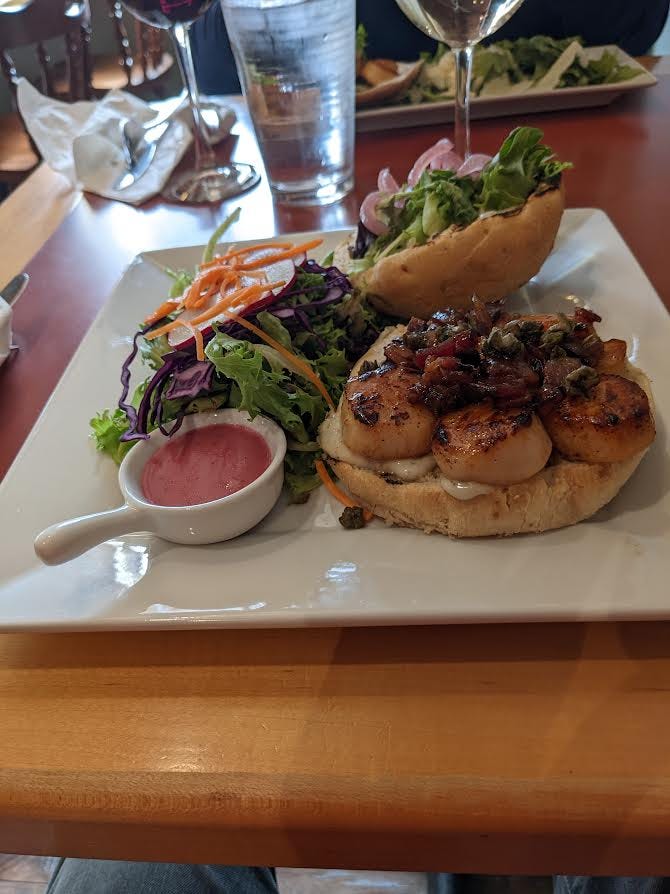This is…spring? It could be Sheila’s Brush, the traditional snow following Saint Patrick’s Day, but it landed two days early.
After silence, the birds return. In this particular rite of spring, it’s not the hesitancy of Stravinsky’s woodwinds that fill my ears, but rather the sound of eagles wheeling across the sky; the hoarse whistle of a red-tailed hawk, and the hunting calls of owls. Even though, technically, it’s still winter, spring is on the land.
A mourning dove coos.
Previously, spring has never been my favourite season; in fact, it’s almost always been my least loved. But that might change. I viewed it the way other people looked upon the fall: dull, dark, dismal. But this year I look forward to the hesitant green shoots poking above ground, the insistent noise of birds.
Soon it will be time to set the plants in the ground, the beginnings of our garden. This year will include lettuce, peppers, cabbage, carrots, potatoes - lots of potatoes - tomatoes, and much more. We will thumb our noses at the grocery stores and their ridiculous prices, just the same as we do with the power company.
The woodpeckers rattle and chatter.
May will mark three years for us here. The changes to the house, the property, our lives have been unimaginable, often unintended. I have come to love it here and can’t imagine living anywhere else.
I’m happy to be here.
Then…silence again. A Nor’easter blows in, shaking the trees with its gusts. Thick snowflakes blanket the ground before changing over to rain that skitters over the terrain. It’s the kind of mutable storm I associate with spring. It can’t make up its mind whether it wants to herald winter’s final blast, or beat the land into submission with the first soaking of spring.
Inside, by the warmth of the wood fire, I dream of the first early shoots of micro-greens pushing aside the earth.
People make vows on New Year’s. Perhaps the Spring Equinox would be more realistic for those declarations. Such a time of change, leaning into the next year. Summer’s growth follows, Autumn’s bounty results.
Local love: the return of the general store
General stores are returning to Nova Scotia. But these aren’t the stores of days gone-by. These general stories mix a dash of hippie with a smattering of yuppie and end up with something fairly funky. Certainly, they are a boon to the communities in which they’re popping up.
Chicory Blue General Store in Blockhouse.
Over in Blockhouse, the screen to the Chicory Blue General Store bangs open at regular intervals. People from the area are stopping in for lattes; for the rich takes on things like apple-rhubarb muffins and buns; for the roasted vegetable and falafel wraps; and for the locally grown produce nestled beside packaged foods from around the globe.
Nor does the store’s plans stop there. Chicory Blue declares its open style restaurant kitchen and indoor dining area area are still a work-in-progress as is its liquor licence. The proprietors say they love most Middle Eastern and North African cuisine. “Our intention is always to lean hard into local, sustainable, and seasonal produce with an emphasis on plant-based healthy meals. We aren’t shy about our love of cardamom, rose petals, za’atar, harissa, tahini, sumac and loads of fresh herbs and bright flavours,” they note.
Damn. This might prompt another episode of eye-bulging, finger-twitching excitement.
Once a general store, always a general store: Chicory Blue comes by its space honestly. Back in the day, Demas and Esseline Lagille, and then their son Selwyn and his wife Edna, ran the counters. According to the current owners, “The store was a gathering place, a place where people reliably find the essentials of everyday life and, most importantly, connect with others in the community.”
They addd that “There was always a cribbage board set up on a table in back, crowded with local gentlemen, and small crowds would gather on the front porch to debate everything from the weather to local politics.”
The current owners wanted to revitalize a space that was once a community hub in Blockhouse. They didn’t get off to the most auspicious start. The week they bought the property the pandemic was declared. Nonetheless, they continued to operate in a limited capacity through the lockdowns.
Since, they’ve added edible and ornamental gardens, workshops, community meeting rooms, bike rentals, a lending library and tool library, film screenings, music and literary events and private catered parties.
The staff include a farmer/filmmaker, students of sustainability and anthropology, bakers, musicians, actors, baristas and a resident intellectual.
The exterior of Rosa Rugosa Seaside Market in Hubbards.
Hubbards now boasts a new general store as well. Rosa Rugosa Seaside Market declares that it provides “a mix of everyday essentials and specialty goods, with a focus on quality products made in Nova Scotia. “
The market carries farm-fresh produce, cured meats, baked goods, cheese, fresh herbs and more, according to Rosa Rugosa. The shop stocks vintage clothing, antique, furniture, crystal, chocolates, bath bombs, soap, plants, art, and just about every other thing you’d expect in a new take on a general store.
Apparently, a small cafe is on the premises as well although the menu isn’t online.
According to Nova Scotia historian Mike Parker, who’s written a book titled A Little of Everything: General Stores of Nova Scotia - Remembering the Old Days, Old Ways, more than 1,300 general stories used to populate the province.
Parker told CBC News that mail order catalogues and shopping malls ended the heyday of general stores in Nova Scotia. "I, more than most, probably mourn the passing of general stores," Parker recollected in an interview with the public broadcaster, "because my family owned and operated a general store, the Bear River Trading Company in Bear River for 40 years."
With their dedication to local products, strong sense of community, and the way they impart an individuality as they anchor neighbourhoods and regions of the province, the return of the general store is a welcome trend in Nova Scotia.
What I’m reading
Here’s a novel about trees, about families, and about family trees. Again, another Canada Reads selection this year, Greenwood is a subtly shifting story with a large narrative sweep (please, forgive the alliteration; it’s not intentional). The book spans the year 2038 back through to 1908 and ties together the fortunes of a several families. From timber barons to tramps, everyone is linked in this swiftly moving novel. Greenwood picks you up like a river and transports you miles from where you began before you’re even aware of what is happening. This year’s Canada Reads theme is shifting perspectives, and Greenwood certainly does that. When it comes time to debate the winner, it will be fascinating to hear the argument for the winning book as soon many of this year’s contenders stick tightly to the theme.
What I’m listening to
Mixing blues, honky-tonk, and country, Vancouver roots musician Jim Byrnes offers a toe-tapping, dance floor mix of favourites. He covers Hank Snow’s immortal I’m Movin’ On, and songs from the likes of Gordon Lightfoot, Buck Owens, and Dolly Parton. Multiple Juno Award-nominated guitarist Steve Dawson accompanies, as do other well-known session musicians such as Rob Becker on bass. On Pickin’ Wild Mountain Berries, singer Colleen Rennison - who is probably better known as an actress these days - takes a turn on vocals. On those nights you can’t make it down to the local roadhouse, crack a beer, kick back and relax, because Byrnes brings the roadhouse to you.
What I’m eating, or the po’boy dissertation
The scallop po’boy at Rebecca’s.
Recently, I worried about the Bayport Pub’s purchase of Rebecca’s Restaurant and what the changes might mean to the quality of the latter restaurant. So far, I’m happy to report, there’s no reason for concern when it comes to the food. At a recently lunch I had the scallop po’boy, and it was absolutely delicious, jammed with tender scallops.
Technically, I wouldn’t have called it a po’boy. I associate the latter with a long, butter-slathered bun, which this po’boy declined to offer. Over at Serious Eats, where - in my mind, they sometimes take their food wa-a-a-y too seriously - J. Kenji Lopez-Alt, who is the most serious eater of them all, only deigned to call one “the Louisiana equivalent of a submarine sandwich.” That’s pretty short shrift from a guy who just recently “Spent 5 Months Studying Chicago Thin-Crust Pizza” over at the New York Times.
A more authoritative take may be found over at 64 Parishes. The latter describes itself as “a project of the Louisiana Endowment for the Humanities (LEH). Since 1971, LEH has partnered with communities, institutions, and individuals to explore Louisiana’s past, reflect on our present, and imagine our future. LEH began publishing a quarterly magazine, Louisiana Cultural Vistas, in 1990. In 2008, LEH launched KnowLA, the online encyclopedia of Louisiana. 64 Parishes represents the evolution of this tradition, creating content that reflects the partnerships, programs, and mission of the Louisiana Endowment for the Humanities.”
Who knew? I love it.
Michael Mizell-Nelson, PhD. writes that “poor boy sandwiches, commonly known as “po-boys,” represent bedrock New Orleans culinary culture—in effect, the shotgun house of New Orleans cuisine.”
He notes the “crisp, French bread loaves have served as a culinary crossroads, encasing the most pedestrian and exotic of foods: shrimp, oyster, catfish, soft-shell crabs, and fried eggplant as well as French fries and ham and cheese. Comfort food in other cities seldom exhibits such breadth.”
Mizell-Nelson traces the origin of the sandwich to Martin Brothers’ French Market Restaurant and Coffee stand in 1929. The stand developed a new loaf, originally 40 inches long that allowed the restaurant to make inexpensive sandwiches made of cheaper cuts of meat.
Beyond the culinary implications, Mizell-Nelson delves into the cultural background of the sandwich, which is well worth taking the time to explore, and looks at the variation and meaning behind the sandwich’s name, noting among other things that the term “poor boy” likely was applied ironically because the striking street railway workers for whom the sandwich was originally developed had been among the highest-paid workers in the city since unionizing in 1902.
Despite these quibbles over whether Rebecca’s sandwich qualifies as a po’boy, I’d have one again. But make no mistake, Rebecca’s is not a po’boy but a scallop burger in disguise, albeit a very tasty one.







Spring ephemerals !
This line is wonderful: "These general stories mix a dash of hippie with a smattering of yuppie and end up with something fairly funky." Poetic and rhythmic. Nice!